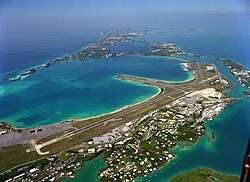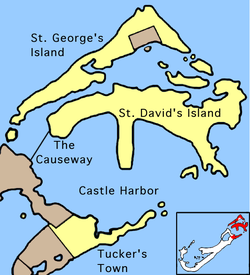Fort Bell Army Airfield
| Kindley Air Force Base | |||||||
|---|---|---|---|---|---|---|---|
| St. David's Island, Bermuda Near St. George's, Bermuda in United States |
|||||||

The former AFB Kindley Field, as it appeared in 1993
|
|||||||

St. David's Island, after the construction of the airfield. The airfield encompasses all of the Island.
|
|||||||
| Coordinates | 32°21′52.3″N 64°40′53.5″W / 32.364528°N 64.681528°WCoordinates: 32°21′52.3″N 64°40′53.5″W / 32.364528°N 64.681528°W | ||||||
| Type | Air force base | ||||||
| Site information | |||||||
| Owner |
|
||||||
| Operator |
|
||||||
| Open to the public |
Yes | ||||||
| Condition | Operational - returned to the Bermudan government for use as L.F. Wade International Airport | ||||||
| Site history | |||||||
| Built | 1941-1943 | ||||||
| In use | 1943-1995 | ||||||
| Fate | Returned to the Bermudan government for use as L.F. Wade International Airport | ||||||
| Battles/wars | World War II | ||||||
| Airfield information | |||||||
| Identifiers | IATA: BDA, ICAO: TXKF | ||||||
| Elevation | 12 feet (4 m) AMSL | ||||||
|
|||||||
Kindley Air Force Base was a United States Air Force base in Bermuda from 1948–1970, having been operated from 1943 to 1948 by the United States Army Air Forces as Kindley Field.
Prior to American entry into the Second World War, the governments of the United Kingdom and the USA led by Prime Minister Winston Churchill and President Roosevelt came to an agreement exchanging a number of obsolete ex-US Naval destroyers for 99-year base rights in a number of British Empire West Indian territories. Bases were also granted in Bermuda and Newfoundland, though Britain received no loans in exchange for these. This was known as the destroyers for bases deal.
As the government of Bermuda had not been party to the agreement, the arrival of US engineers in 1941 came as rather a surprise to many in Bermuda. The US engineers began surveying the colony for the construction of an airfield that was envisioned as taking over most of the West End of the Island. Frantic protests to London by the Governor and local politicians led to those plans being revised. The US Army would build an airfield at the north of Castle Harbour. The US Navy would build a flying boat station at the West End
The airfield was intended to be a joint US Army Air Forces/Royal Air Force facility, to be used by both primarily as a staging point for trans-Atlantic flights by landplanes. When the US Army occupied the area, it created Fort Bell, with Kindley Field (named in honour of an American pilot, Field E. Kindley, who had served with the Royal Flying Corps during World War I), being the airfield within it.
...
Wikipedia

